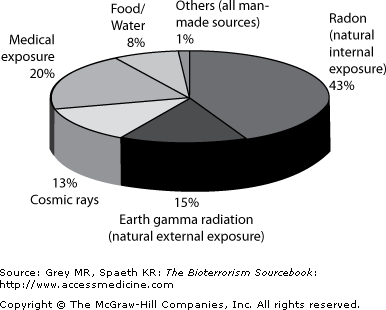An Overview of Radiation Physics and Injury
Life on earth evolved in a shower of ionizing radiation. Indeed, evolution as we currently understand it is singularly dependent on ionizing radiation’s capacity to alter genomic sequences and change the structure and function of intracellular proteins. The human body experiences some 1012 collisions daily from ionizing radiation from a wide range of cosmic and earth-bound sources (Fig. 28–1). For obvious reasons, therefore, humans have evolved repair mechanisms and genetic redundancies that enable us to withstand these exposures without obvious effect. Much of the information used to determine the health effects of radiation on humans derives from the atomic bombing of Hiroshima and Nagasaki, as well as industrial, research, and environmental accidents. To better understand the health effects of ionizing radiation, and specifically, the issue of nuclear terror, this section provides a short introduction to radiation terminology and radiation physics.
Radiation is the transfer of energy through space as electromagnetic waves or particulate matter. The energy contained in radiation is inversely proportional to the wavelength. There are two types of radiation: nonionizing and ionizing. Ionizing radiation is of short electromagnetic length and high energy and has the capability to break covalent nuclear bonds; thereby altering genomic sequences, destroying the structure and function of proteins, and generating free radicals that are directly cytotoxic. Higher-frequency wavelengths (e.g., x- or gamma rays and alpha particles) have higher energy and are more destructive than low-frequency radiation (e.g., radiowaves or microwaves). Nonionizing radiation (e.g., microwaves and radiowaves) is not considered potential weapon of terror and is not discussed further (Table 28–1).
| Region | Wavelength (Cm) | Frequency (Hz) | Energy (Joules) |
|---|---|---|---|
| Radio | >10 | <3 × 109 | <10−24 |
| Microwave | 10 − 0.01 | 3 × 109 − 3 × 1012 | 10−24 |
| Infrared | 0.01 − 7 × 10−5 | 3 × 1012 − 4.3 × 1014 | 10−23 − 10−19 |
| Visible | 7 × 10−5 − 4 × 10−5 | 4.3 × 1014 − 7.5 × 1014 | 10−19 |
| Ultraviolet | 4 × 10−5 − 10−7 | 7.5 × 1014 − 3 × 1017 | 10−19 − 10−17 |
| X-rays | 10−7 − 10−9 | 3 × 1017 − 3 × 1019 | 10−17
Stay updated, free articles. Join our Telegram channel
Full access? Get Clinical Tree
 Get Clinical Tree app for offline access
Get Clinical Tree app for offline access

|






